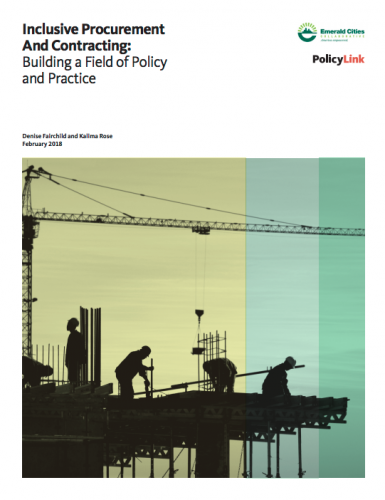This study, co-authored by Emerald Cities and PolicyLink, and generously supported by a grant from the Annie E. Casey Foundation, surveys the current landscape on inclusive procurement and contracting policies and practices in the infrastructure and construction industries. The goal was to specifically determine how to best position minority-owned, women-owned, and disadvantaged businesses (MWDBEs) to effectively compete for large-scale construction projects in these industries. A successful inclusive procurement program of action is key not only to providing jobs, but also to closing the wealth gap needed to secure the well-being and future of children, families, and the regions in which they live.
Download Inclusive Procurement and Contracting
This report details the rationale for inclusive practices in this industry and includes historical and current equitable development policies and trends. It also identifies challenges and best practices and sets forth recommendations for strengthening the field of practice. The report provides insight into inclusive procurement and contracting policies within the energy, water, transportation, health, education, and public housing sectors. It also considers the field of practice in different geographic regions of the United States.
Table of Contents
Executive Summary
Key Findings
Why Inclusive Procurement Matters
Growth and Impact of Minority-Owned and Women-Owned Business Enterprises
The Demand: Enormous Market Opportunities
The Supply: Labor Shortages
Closing the Gap: An Equity-Based Solution
Inclusive Procurement and Contracting Policy Primer
Background on Federal Policies
The 21st Century Federal Policy Landscape
The State and Local Policy Landscape
Navigating the Political Landscape: Race-Averse versus Race-Conscious Policies
The Geographic Landscape
Sector-Specific Inclusive Policy Levers
Policy Conclusions
Policy Recommendations
Inclusive Procurement and Contracting Practices
Strengthening Demand-Side Factors
Strengthening Supply-Side Factors
Conclusions and Practice Recommendations
Inclusive Procurement and Contracting Field Building
Mapping the Field
Role of Community Organizations
Messaging and Communication
Field Building Recommendations
Appendixes
Appendix A: List of Interview Participants
Appendix B: State Agency Overview Matrix
Notes and Bibliography
Sources: PolicyLink





